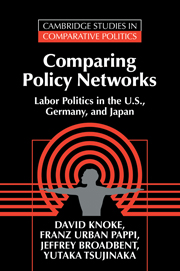Book contents
- Frontmatter
- Contents
- List of tables and figures
- Preface
- Acknowledgements
- 1 Policy-making in the Organizational State
- 2 Three Labor Policy Domains
- 3 Finding Domain Actors
- 4 Organizational Policy Interests
- 5 Policy Webs: Networks, Reputations, and Activities
- 6 Fighting Collectively: Action Sets and Events
- 7 Exchange Processes
- 8 Power Structures
- 9 Variations on a Theme of Organizational States
- Appendix 1 Legislative Procedures in Three Nations
- Appendix 2 Labor Policy Domain Organizations by Type
- Appendix 3 Cluster Analyses of Labor Policy Domain Issues
- Appendix 4 Labor Policy Domain Legislative Bills
- References
- Index
3 - Finding Domain Actors
Published online by Cambridge University Press: 05 June 2012
- Frontmatter
- Contents
- List of tables and figures
- Preface
- Acknowledgements
- 1 Policy-making in the Organizational State
- 2 Three Labor Policy Domains
- 3 Finding Domain Actors
- 4 Organizational Policy Interests
- 5 Policy Webs: Networks, Reputations, and Activities
- 6 Fighting Collectively: Action Sets and Events
- 7 Exchange Processes
- 8 Power Structures
- 9 Variations on a Theme of Organizational States
- Appendix 1 Legislative Procedures in Three Nations
- Appendix 2 Labor Policy Domain Organizations by Type
- Appendix 3 Cluster Analyses of Labor Policy Domain Issues
- Appendix 4 Labor Policy Domain Legislative Bills
- References
- Index
Summary
Identifying the important organizations, relations, issues, and events in a policy domain requires researchers to make both conceptual and empirical decisions. We sought to map the essential features of the U.S., German, and Japanese national labor policy domains during the 1980s, but without capturing so much detail that our pictures became too cluttered for comprehension. Our task involved painstaking choices among empirical indicators of the conceptual elements described in Chapter 1. This chapter outlines the data collection and measurement procedures that we followed and the results that we obtained.
SPECIFYING DOMAIN BOUNDARIES
Which analytic components fall inside a national policy domain, and which ones fall outside? Every domain is a continually changing bundle of organizations, events, and activities. Because convenient membership lists do not exist, researchers must develop methods for identifying the members that are unique to each domain. In their cogent discussion of the boundary specification problem in network analysis, Laumann, Marsden, and Prensky (1983) offered two “metaphysical perspectives,” the realist and the nominalist. The realist approach relies on participants to be knowledgeable informants. It assumes that all or most actors share a subjective awareness of who belongs to a social system. Thus, a representative cross-section of the social system's participants can inform a researcher about who are its members and which activities are significant. We find the realist perspective less compelling for large, complex national policy domains. Some participants are aware of only small portions of the entire structure.
- Type
- Chapter
- Information
- Comparing Policy NetworksLabor Politics in the U.S., Germany, and Japan, pp. 66 - 76Publisher: Cambridge University PressPrint publication year: 1996



